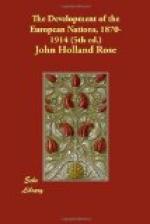The next important barrier to the advance was the river Atbara. Here the Dervishes had a force some 18,000 strong; but before long the Sirdar received timely reinforcement of a British brigade, consisting of the Cameron and Seaforth Highlanders and the Lincolnshire and Warwickshire regiments, under General Gatacre. Various considerations led the Sirdar to wait until he could strike a telling blow. What was most to be dreaded was the adoption of Parthian tactics by the enemy. Fortunately they had constructed a zariba (a camp surrounded by thorn-bushes) on the north bank of the Atbara at a point twenty miles above its confluence with the Nile. At last, on April 7, 1898, after trying to tempt the enemy to a battle in the open, the Sirdar moved forward his 14,000 men in the hope of rushing the position soon after dawn of the following day, Good Friday.
Before the first streaks of sunrise tinged the east, the assailants moved forward to a ridge overlooking the Dervish position; but very few heads were seen above the thorny rampart in the hollow opposite. It was judged to be too risky at once to charge a superior force that clung to so strong a shelter; and for an hour and a half the British and Egyptian guns plied the zariba in the hope of bringing the fanatics out to fight. Still they kept quiet; and their fortitude during this time of carnage bore witness to their bravery and discipline[414].
[Footnote 414: The Egyptian Sudan: its Loss and Recovery, by H.S.L. Alford and W.D. Sword, ch. iv.]
At 7.45 the Sirdar ordered the advance. The British brigade held the left wing, the Camerons leading in line formation, while behind them in columns were ranged the Warwicks, Seaforths, and Lincolns, to add weight to the onset. Macdonald’s and Maxwell’s Egyptian and Sudanese Brigades, drawn up in lines, formed the centre and right. Squadrons of Egyptian horse and a battery of Maxims confronted the Dervish horsemen ranged along; the front of a dense scrub to the left of the zariba. As the converging lines advanced, they were met by a terrific discharge; fortunately it was aimed too high, or the loss would have been fearful. Then the Highlanders and Sudanese rushed in, tore apart the thorn bushes and began a fierce fight at close quarters. From their shelter trenches, pits, and huts the Dervishes poured in spasmodic volleys, or rushed at their assailants with spear or bayonet. Even at this the fanatics of the desert were no match for the seasoned troops of the Sirdar; and soon the beaten remnant streamed out through the scrub or over the dry bed of the Atbara. About 2500 were killed, and 2000, including Mahmud, the commander, were taken prisoners. Those who attempted to reach the fertile country round Kassala were there hunted down or captured by the Egyptian garrison that lately had arrived there.




